Circulation pump
A circulation pump is an electrically driven circulation pump for use in drinking water installations. The pump parts that come into contact with the (heated) drinking water must be made of suitable materials such as brass, stainless steel, ceramics and / or selected plastics.
In addition to the classic circulation pumps with canned motors or permanent magnet motors, there are modern, electronically controlled variants with EC motors (high-efficiency pumps).
Use and benefit
The circulation pump is used in central drinking water heating systems in the circulation line in order to "supply any number of consumers with hot water via a branched pipe network, even those that are further apart". The centrally heated drinking water is permanently circulated in the drinking water pipes and made available immediately at every tap. Without circulation, the standing hot water cools down in the line, which means that when the hot water tap is turned on, the cooled water flows out before hot water flows in.
advantages
The circulating hot water represents an increase in user comfort and, above all, ensures hygiene (see Legionella ) in accordance with the Drinking Water Ordinance and the technical data sheets W551 and W553 of the DVGW .
disadvantage
"The greater comfort usually results in higher system costs and - due to the pipe losses - greater losses, which can, however , be kept within limits by appropriate regulations ( circulation control ) and insulation of the pipes".
In the event of incorrect hydraulic balancing of the system, incorrect design of the pump or pipes, inadequate insulation or other planning errors, the temperature in the circulation line can drop to below 55 degrees Celsius even when the pump is running. With hot water temperatures below 55 degrees Celsius, there is a risk of legionella colonization.
Situation in Germany
The circulation pump is a requirement resulting from the Drinking Water Ordinance and DVGW worksheet W551, with the aim of preventing the growth of legionella. Accordingly, large systems with a water volume of more than 3 liters between the drinking water heater and at least one tapping point must be equipped with a circulation line (or trace heating). The circulation pump ensures the water is transported back to the hot water generator via the ring line and the circulation line.
See also
Individual evidence
- ↑ DIN 1988 Technical rules for drinking water installation . Beuth publishing house.
- ↑ DIN EN 16421 Influence of materials on water for human consumption - multiplication of microorganisms . Beuth publishing house.
- ↑ Prof. Dipl.-Ing. Wolfram Pistohl: Handbook of building technology . 7th edition. tape 2 . Werner Verlag, Cologne 2009, ISBN 978-3-8041-4685-3 , p. H188 .
- ↑ BitSign GmbH: circulation pump - SHKwissen - HaustechnikDialog. Retrieved May 2, 2018 .
- ↑ a b Prof. Dipl.-Ing. Wolfram Pistohl: Handbook of building technology . 7th edition. tape 1 . Werner Verlag, Cologne 2009, ISBN 978-3-8041-4684-6 , p. B43 .
- ↑ BitSign GmbH: Circulation line - Drinking water - SHKwissen - HaustechnikDialog. Retrieved May 2, 2018 .
- ↑ Wasser-Praxis 2/2012 ( Memento of the original dated February 27, 2012 in the Internet Archive ) Info: The archive link was inserted automatically and has not yet been checked. Please check the original and archive link according to the instructions and then remove this notice. (PDF; 2.1 MB)
